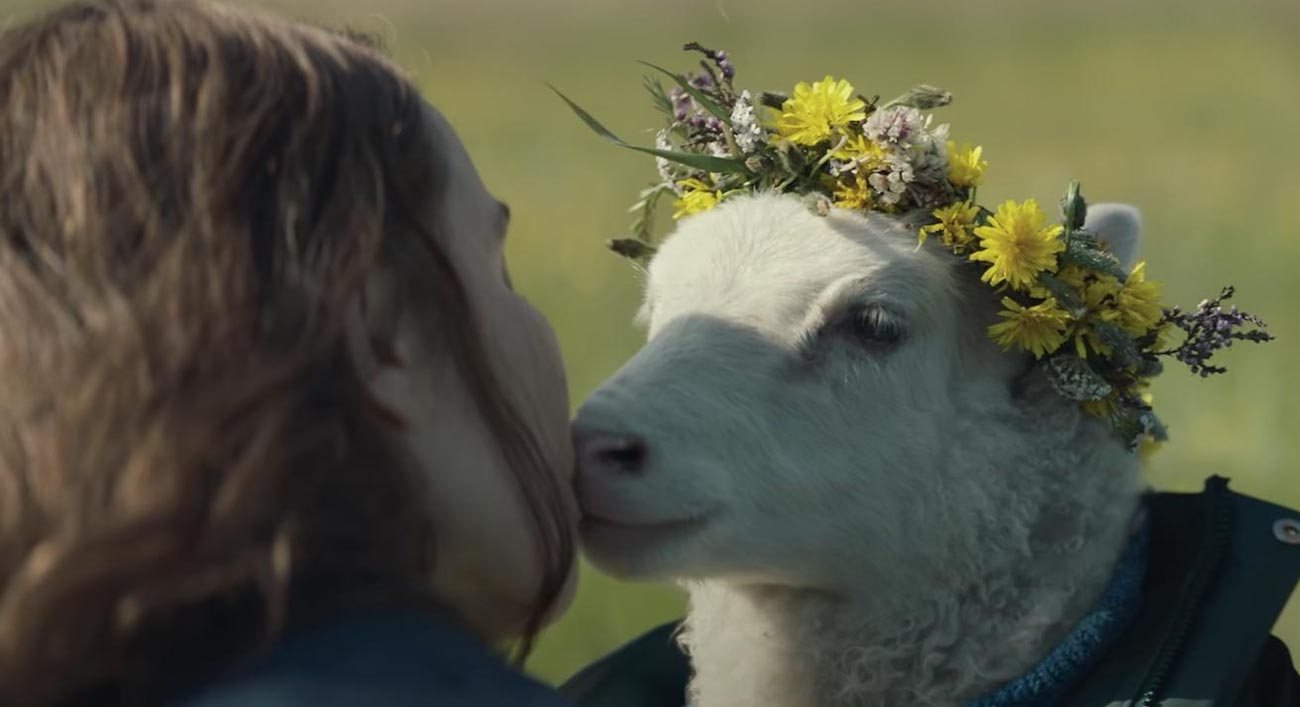It’s the briefest of pauses—the moment where Noomi Rapace’s Maria becomes totally besotted with the sheep-human hybrid at the heart of Valdimar Jóhannsson’s Lamb. In the dark of night, and at the tail end of a new crop of sheep being born, Maria and her husband Ingvar (Hilmir Snær Guðnason) have welcomed into this world any number of baby lambs, each being lovingly licked and doted on by their mothers. And yet, when the final creature to be born turns out to be not quite lamb, nor quite human, it takes only an instant for Rapace to decide she’ll claim the child as her own, nuzzling her face into its wool like any other parent. Audiences are thus immediately asked to consider just how thin the line is between human and animal, man and nature. It is minuscule but, given the disapproving stares of the other sheep, it is firm.
Such is the startling setup of Lamb, a bizarre and lyrical film which on paper sounds like the punchline to a barroom joke. Yet writer-director Jóhannsson, working from a screenplay he co-wrote with the poet Sjórn, smothers any sense of humor or irony beneath an unrelenting tide of naturalism and even sentiment. Indeed, the most disturbing thing is how non-disturbing it ultimately becomes. This is a film which can be downright blissful in its domesticity. And for some that may be why it’s so unnerving.
Told in three chapters, Lamb reveals its first-time director to already be a strong aestheticist, setting a somber and primal atmosphere. In fact, much of that first chapter is a silent film as we bear witness to the wordless ennui that’s wrapped itself around Maria and Ingvar’s lives. A past tragedy which neither will speak of has left their home empty, and their souls absent. Christmas Eve comes and goes with neither hearing the cries of the sheep as a visitor descends among their flock. And when the spring comes, the surprise of the child they name Ada is as much a relief as she is mystery: an abomination that’s also godsend, here to fill a hole.
Of course as farmers they have plenty of animals that would seem to disagree. For much of the movie we barely see Ada, but we watch closely at the way the cat stares. And the sound of Ada’s actual mother? She bays forlornly outside of Maria and Ingvar’s nursery every night, demanding her child back. Still, for the adoptive parents, it is as they say, “happiness.” Only the occasional image of a hoof drifting into frame next to a child’s hand can crack this portrait of familial joy. However, when Ingvar’s own black sheep enters the picture, dissolute brother Pétur (Björn Hlynur Haraldsson) who’s again shown up with nowhere else to go, illusions are just waiting to be shattered.
The brilliance of Lamb very much comes from its understanding of illusions, and when it’s best to conceal instead of reveal. As Jóhannsson weaves his mythic fairy tale, we are always seeing slightly more of Ada and her personality. We discover how she sits and how she eats at the table; study the way she reacts to a stranger in the house; even her level of intelligence is hinted at when she’s asked to turn off the radio by a parent and does so. Yet how this action is obfuscated by occurring only in the reflection of a kitchen appliance always encourages the audience to lean forward and become further fascinated and baffled by the good daughter.
The way she is realized, through a series of techniques which includes live lambs, child actors, and even CGI, is impressive, but what brings her to life are the performances of all three humans in her purview. It’s how her family reacts. Chief among them is Rapace’s emotionally raw performance as mother Maria.
Still the best onscreen Lisbeth Salander, Rapace has had a long career which has taken her to Hollywood and back again. But with the Icelandic Lamb, she offers her best work since The Girl with the Dragon Tattoo. As a mother deeply wounded by a loss which predates Ada’s arrival, Rapace’s protagonist has something broken in her that we can never really know. It’s the shipwreck hidden beneath still waters. But the ghosts are still present, and she only begins putting them to rest when she is allowed to put flowers in a lamb’s hair.
It’s a remarkable turn, and both she and Guðnason do significant work at normalizing the concept of Ada and the happiness she brings. However, that happiness will, by design, unsettle some audiences and also likely disappoint others. A24 has perhaps wisely marketed Lamb as another one of their bizarre “elevated” horror movies (if you believe in such terms). But while Lamb shares some thematic DNA with the folk horror of, say, The Witch or Midsommar, it is more of a genuine folk tale with bleak contours and morals. Even if it isn’t necessarily a happy story, Lamb is a heartwarming one. This is a movie about how the heart supersedes all logic, even if the entire world tells you otherwise. That can be the stuff of horror, sure, but it also defines any parent’s love.
Lamb opens in theaters in the U.S. on Oct. 8 and in the UK on Dec. 10.
